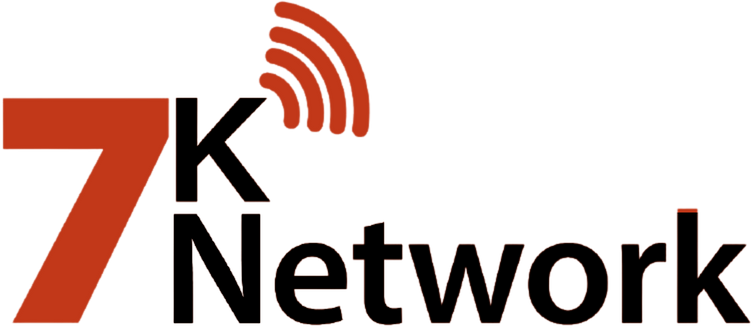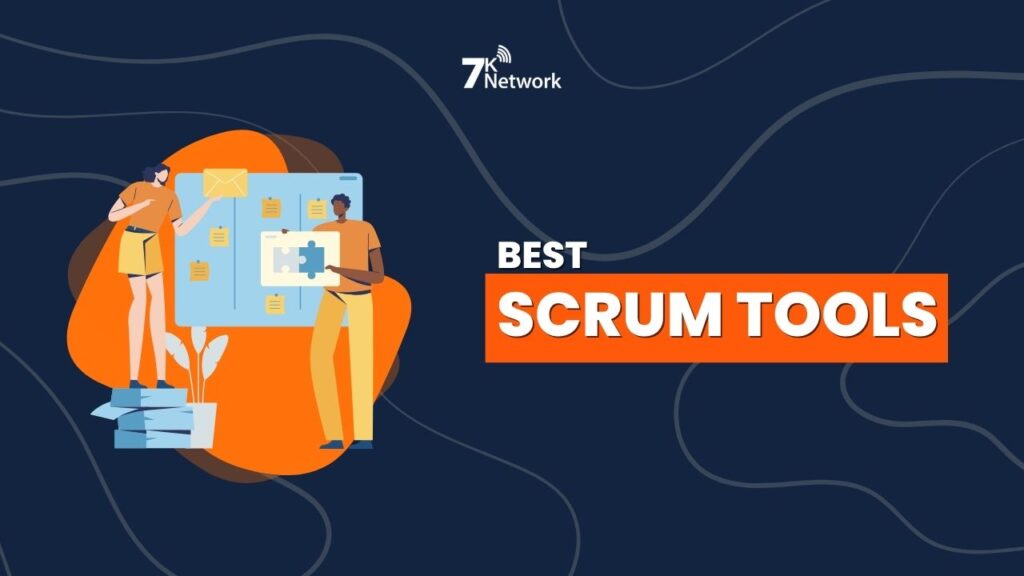Teams that implement Agile practices need the best Scrum tools to achieve maximum productivity. Modern high-speed work environments benefit from Scrum software, which automates multiple aspects, including sprint planning, task assignment, project delivery, and team coordination. Software tools that use Scrum frameworks serve various industries by enabling working professionals, including developers and product managers as well as marketing specialists and designers, to automate operations. Also, fostering visibility and facilitating their response to evolving needs.
This article presents a selection of the 19 best Scrum tools evaluated according to core Agile features, user-friendly interfaces, scalability options, integration capabilities, and collaboration functions, together with pricing flexibility. These tools serve businesses of all sizes, resulting in better Agile practices that become both efficient and organized, and driven toward healthy results.
What are Scrum Tools?
Organizational platforms, Scrum tools provide digital support which helps Agile teams execute projects according to Scrum framework guidelines. The tools help teams organize their work while planning sprints to assign duties each team member should carry out, with progress tracking support for communication management and project deadlines. The essential features of Agile collaboration and continuous improvement are strongly supported by these digital platforms because they implement core Scrum functions, including backlogs, together with sprint boards, burndown charts, and daily stand-ups.
Criteria for Selecting the Best Scrum Tools
Requirements for selecting the best Scrum tools to enable Agile teams to plan, organize, and deliver projects more effectively:
- Must-Have Scrum Features: The best scrum tools should enable must-have Scrum features like sprint planning, backlogs, user stories, task boards, and burndown charts.
- Ease of Use: It should be user-friendly so that the product owners, Scrum masters, and team members can easily use it without a learning curve.
- Customization: Team size and process maturity vary. Quality tools enable customizable workflows, task presentation, and reporting to cater to varying needs.
- Integration Capabilities: Advanced Scrum tools include integration capabilities to enable them to integrate seamlessly with popular development platforms such as GitHub, Jira, Slack, Trello, Google Workspace, and CI/CD pipelines.
- Real-time collaboration: It is simpler to stay on the same page with teams through features like real-time task updates in addition to file sharing and commenting, and notification help remote and hybrid teams.
- Analytics and Reporting: Dashboards, velocity charts, sprint reports, and KPIs allow tracking progress, identifying bottlenecks, and making data-driven decisions.
- Scalability and Team Management: The best scrum tools should be scalable for managing small teams, medium teams, large teams, permissions, role permissions, and multiple projects or teamwork.
- Performance and Dependability: A robust platform with less downtime and prompt customer support is of the highest priority, especially in the scenario of product development at a large scale.
- Price and Value: It must be worth the cost, either free for small organizations or startup/small business-friendly prices.
- Support and Community: Thorough documentation, guides, living user communities, and supportive channels mean onboarding and debugging are trivial.
List of 19 Best Scrum Tools
1. Jira

Atlassian’s Jira is one of the best Scrum tools and a popular Agile project management software. It has support for Scrum and Kanban methodologies, sprint planning, backlog grooming, and live reporting. Perfect for software development teams, Jira has native integration with development tools such as Bitbucket and Confluence. It’s scalable and has customizable workflows, making it perfect for startups as well as big organizations handling complex Agile projects.
Key Features:
- Scrum and Kanban boards
- Backlog and sprint planning
- Custom workflows and automation
- Integration with Confluence, Bitbucket, and more
Pros:
- Highly customizable for complex workflows
- Strong integration ecosystem
Cons:
- Steeper learning curve for beginners
- Can be overwhelming for small teams
Pricing:
Free for up to 10 users, paid plans start at $7.53/user/month
Who Should Use It?
Mid to large development teams, especially those needing deep integrations and custom workflows.
Suggested Blog: Top Jira Tracking Software
2. Trello
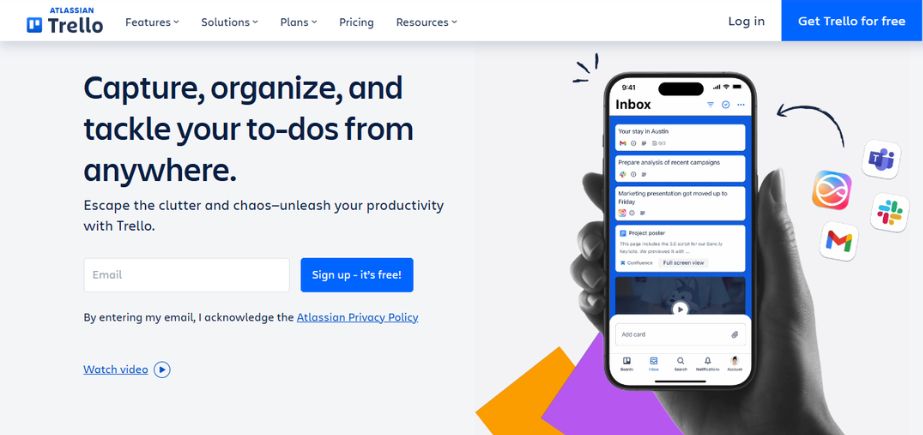
Trello offers a simple, visual way to handle tasks using boards, lists, and cards. Although not Scrum-specific, it is easily set up using templates and Power-Ups to fit Agile processes. It’s the default for tiny teams and startups that need a lightweight, flexible project management tool. Trello’s drag-and-drop platform is simple enough to make sprint planning and collaboration easy for non-tech teams as well.
Key Features:
- Drag-and-drop Kanban boards
- Power-ups for added features
- Checklists, due dates, attachments
- Easy team collaboration
Pros:
- Intuitive and user-friendly
- Great for visual task management
Cons:
- Lacks advanced Agile features natively
- Dependency on Power-Ups for key features
Pricing:
Free with limited features, paid plans start at $5/user/month
Who Should Use It?
Startups, small teams, and non-technical teams looking for lightweight Agile boards.
3. Asana
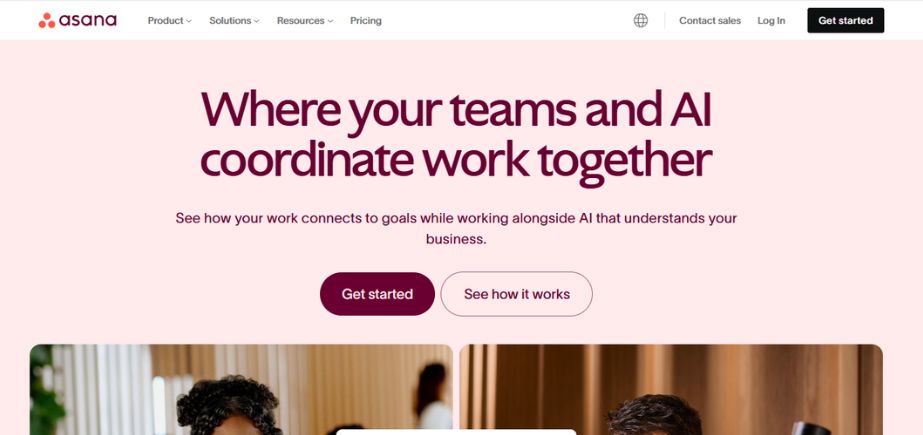
Asana is a generic work management software used by Agile teams to monitor work, plan sprints, and establish goals. It supports timeline views, personal workflows, and real-time collaboration among teams. It’s not a Scrum tool in itself but can be made to conform using boards, custom fields, and integrations to Agile methodologies. It’s ideal for marketing, product, and cross-functional teams that require transparency and accountability.
Key Features:
- Timeline and task dependencies
- Kanban board support
- Sprint and workload management
- Integration with Slack, Google Workspace, etc.
Pros:
- Clean, modern UI
- Great collaboration and notification features
Cons:
- Limited Scrum-specific features out-of-the-box
- No built-in burndown charts
Pricing:
Free for basic use, premium starts at $10.99/user/month
Who Should Use It?
Creative, marketing, and hybrid Agile teams looking for flexible project organization.
4. Monday.com
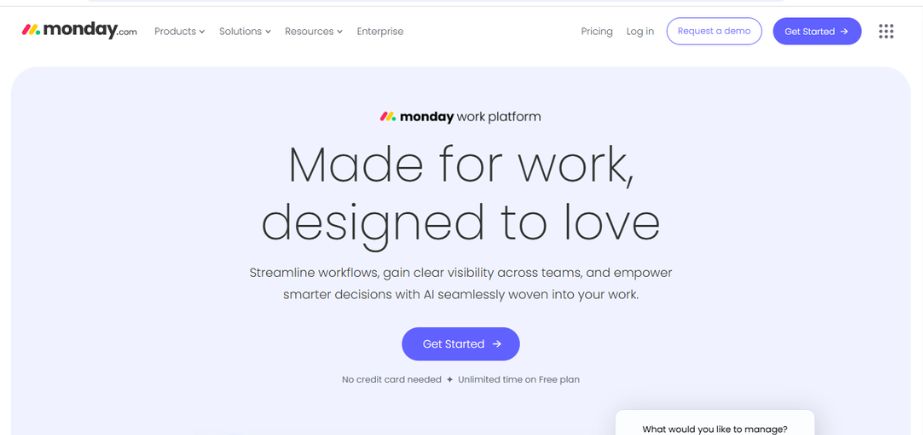
Monday.com is an extremely flexible work operating system supporting Agile and Scrum project management. With the use of visual dashboards, automation, and integrations, teams can schedule sprints, follow backlogs, and organize workflows with ease. Its intuitive nature makes it ideal for both technical and non-technical users. It is suitable for cross-functional teams that are seeking an adaptable, shared environment to work on projects.
Key Features:
- Customizable Scrum workflows
- Sprint planning templates
- Time tracking and dashboards
- Automation and integration options
Pros:
- Highly visual and flexible
- Great for team collaboration and visibility
Cons:
- Advanced features can get expensive
- Might require setup time for Scrum
Pricing:
Starts at $9/user/month; free plan available with limited features
Who Should Use It?
Agile teams looking for flexibility across departments like marketing, product, and development.
5. ClickUp
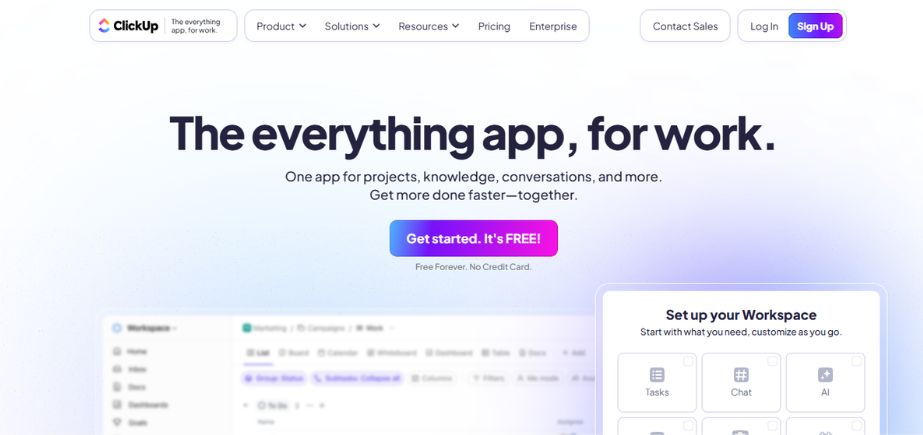
ClickUp unifies task management, time tracking, and goal setting within a single platform that makes it one of the best scrum tools for Agile teams. It includes inbuilt sprints, burndown charts, and personalized Agile workflows, which make it perfect for Scrum teams. Its flexibility allows one to switch between list, board, Gantt, and calendar views. ClickUp is perfect for small and large teams that wish to consolidate work and improve productivity.
Key Features:
- Customizable statuses and workflows
- Agile dashboards and sprint tracking
- Docs, wikis, and goal tracking
- Native time tracking
Pros:
- Highly customizable for Agile workflows
- Combines multiple tools in one platform
Cons:
- May be overwhelming due to its versatility
- Steeper learning curve
Pricing:
Free plan available, paid plans start at $7/user/month
Who Should Use It?
Agile teams seeking a highly customizable and all-in-one project management solution.
6. Zoho Sprints
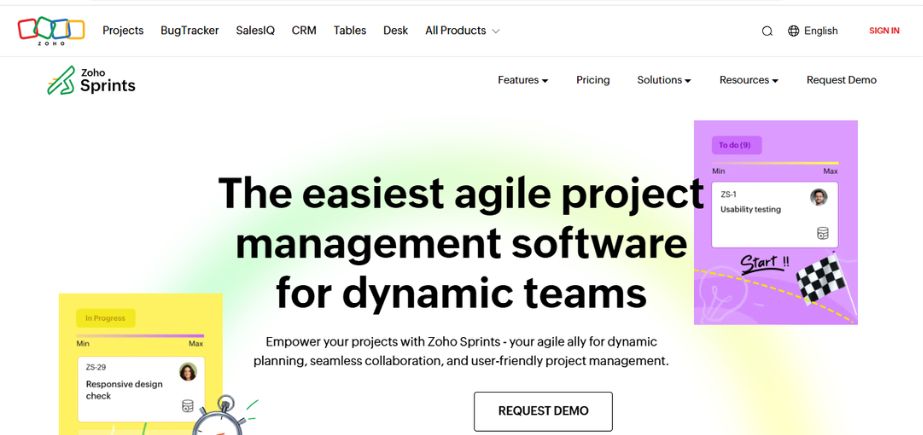
Zoho Sprints is a Scrum project management software specifically designed for Scrum teams. It includes sprint planning, backlog grooming, velocity charts, and burn-up/down reports. It includes a simple-to-use and intuitive interface, native issue management, and time tracking. Zoho Sprints also integrates well with other Zoho applications, so it’s a great choice for teams already on the Zoho platform who are interested in a cost-effective Scrum solution.
Key Features:
- Backlog management and sprint planning
- Timesheet tracking
- Velocity and burn-down charts
- Integration with Zoho ecosystem and GitHub
Pros:
- Clean UI with strong reporting features
- Seamless integration with other Zoho apps
Cons:
- Limited third-party integrations
- Some advanced features are only in paid plans
Pricing:
Free for up to 3 users; paid plans start at ₹70/user/month
Who Should Use It?
Startups and small dev teams using other Zoho products or needing budget-friendly Scrum tools.
7. Wrike
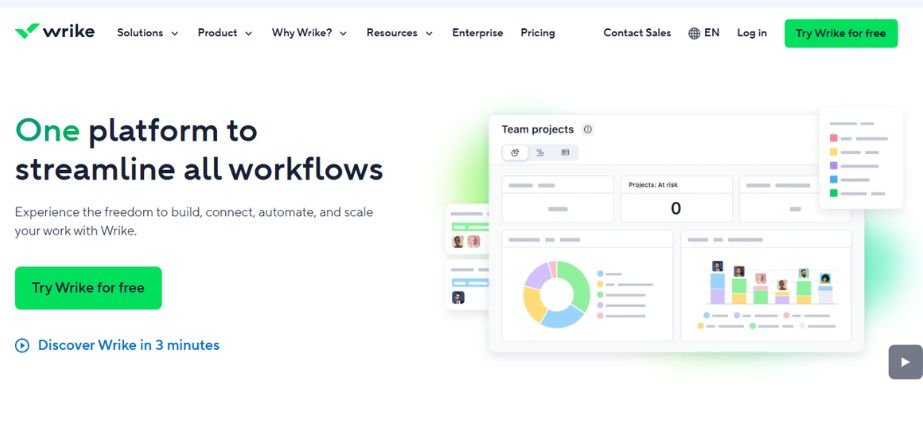
Wrike is a powerful project management solution with Agile methodology support features such as custom workflows, Gantt charts, task dependencies, and collaboration spaces. Though not a Scrum tool by nature, it can be customized to accommodate sprint planning and Agile workflows. It’s especially used by marketing, creative, and product development teams that require flexibility, powerful automation, and solid reporting in one platform.
Key Features:
- Custom workflows and Agile templates
- Time tracking and workload management
- Gantt charts and dashboards
- Real-time updates and collaboration
Pros:
- Excellent for cross-functional team collaboration
- Strong reporting and visualization tools
Cons:
- Interface can feel cluttered
- Can be expensive for small teams
Pricing:
Free plan available; paid plans start at $10/user/month
Who Should Use It?
Medium to large teams handling complex Agile projects across departments.
8. Targetprocess
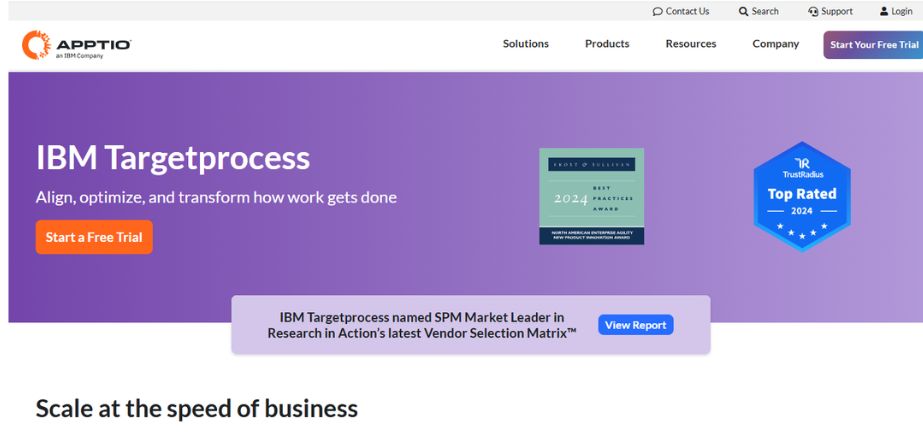
Targetprocess is a corporate-level Agile project management tool meant for Scrum and SAFe framework scaling. It features rich visualization of work, configurable workflows, portfolio management, and seamless integration with tools such as Jira and Azure DevOps. Suitable for big teams, it accommodates user stories, features, epics, and program-level perspectives. Targetprocess is ideal for organizations that run complicated Agile portfolios in several teams or departments.
Key Features:
- Visual Agile boards for Scrum, Kanban, SAFe
- Advanced reporting and dashboards
- Portfolio-level views
- Integration with tools like Jira and Azure DevOps
Pros:
- Ideal for scaling Agile across large orgs
- Highly customizable workflows
Cons:
- Overkill for small teams
- Requires onboarding and training
Pricing:
Custom pricing; free plan available for small teams
Who Should Use It?
Enterprises and large Agile teams implementing SAFe or complex Scrum structures.
9. VersionOne
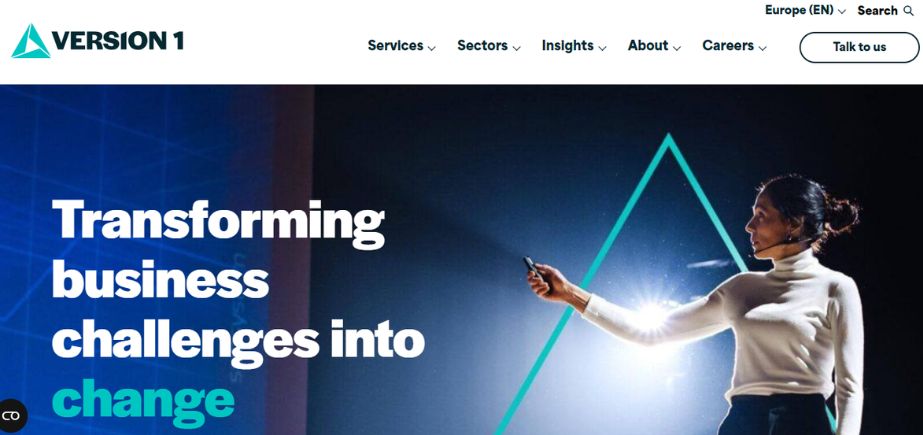
VersionOne, now branded as Digital.ai Agility, is an end-to-end solution designed specifically for enterprise Scrum and Agile teams. It covers all phases of the Agile lifecycle such as backlog management, sprint planning, road mapping at the program level, and analytics for performance. It has scalable capabilities that suit organizations adopting SAFe or any other enterprise Agile methodology. It’s best for big-scale Agile transformations and complicated project environments.
Key Features:
- Storyboards, sprint planning, and backlog management
- Scaled Agile and SAFe support
- Real-time analytics
- Integration with DevOps tools
Pros:
- Built for large-scale Agile environments
- Strong SAFe support and enterprise-level reporting
Cons:
- Complex setup and learning curve
- Premium pricing
Pricing:
Custom pricing; enterprise-focused plans
Who Should Use It?
Enterprises and Agile organizations scaling frameworks like SAFe across departments.
10. Rally Software

Rally Software, previously CA Agile Central, is a robust Agile project management tool that is suited for teams implementing Scrum, Kanban, or SAFe. It has strong release tracking, iteration planning, and team performance metrics tools. Rally is suitable for large-scale enterprise teams that require end-to-end visibility from portfolios to programs. Rally has robust reporting capabilities and alignment features that make it the first choice for Agile scaling across multiple departments.
Key Features:
- Agile release and iteration planning
- Detailed dashboards and metrics
- Portfolio management support
- Integration with Jenkins, Jira, Git, etc.
Pros:
- Enterprise-grade capabilities
- Great for multi-team coordination
Cons:
- Not ideal for small teams
- Pricing is enterprise-focused
Pricing:
Custom enterprise pricing
Who Should Use It?
Large organizations and scaled Agile teams needing advanced governance and metrics.
11. Scrumwise
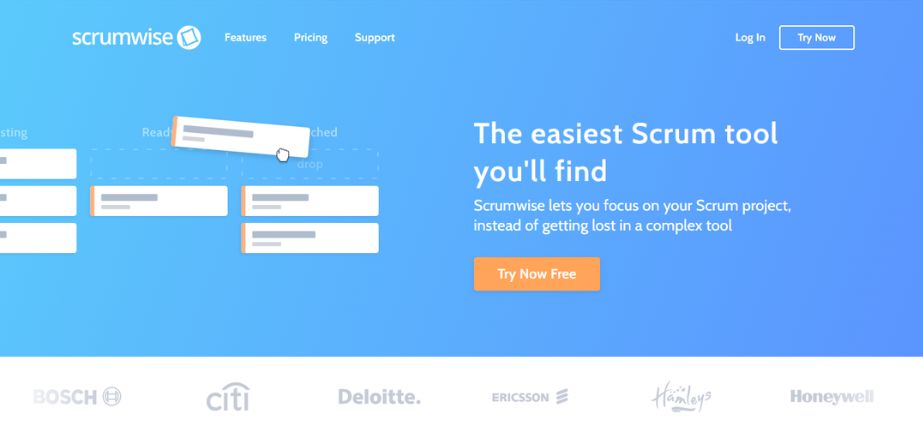
Scrumwise is a light, no-frills tool that is only for Scrum teams. It provides vital features such as product backlogs, sprint planning, task boards, and time tracking but with no frills. Its plain interface is best suited for small to medium-sized teams looking for a no-frills solution that is dedicated to basic Scrum practices. It would be ideal for new Agile teams or teams in need of a less heavyweight alternative to oversized tools.
Key Features:
- Drag-and-drop Scrum boards
- Sprint planning and backlog management
- Burndown charts and time tracking
- Team collaboration tools
Pros:
- Easy to use and learn
- Lightweight with all essential Scrum features
Cons:
- Limited integrations
- Not suitable for scaling Agile across large teams
Pricing:
Starts at $7.50/user/month(yearly plan)
Who Should Use It?
Small to mid-sized development teams looking for a straightforward Scrum-specific tool.
12. Taiga
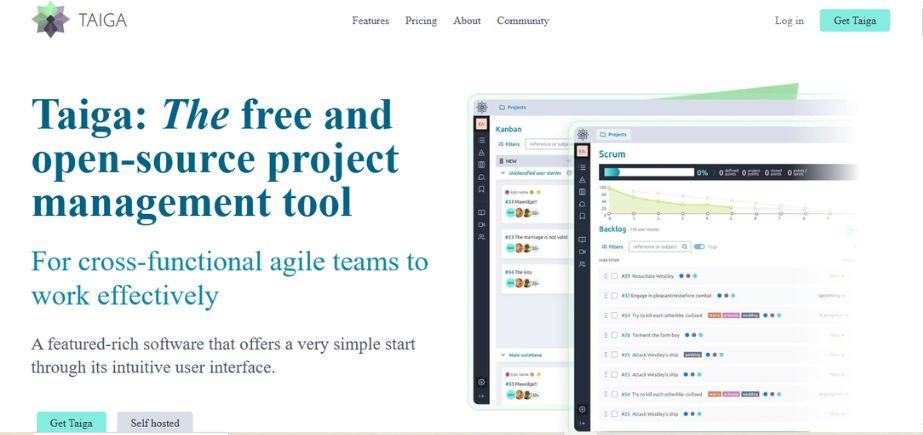
Taiga is a Scrum- and Kanban-strong open-source Agile project management platform. Taiga offers backlogs, sprint planning, burndown, and issue management tools. It is also visual and customizable and, therefore, well-suited for startups, developers, and open-source communities. It is also accompanied by a wiki and integrations along with developer API-accessible components, which renders it suitable for tech-oriented teams that need flexible and collaborative tools.
Key Features:
- Scrum and Kanban boards
- Backlog, sprint, and epic management
- Burndown charts and project wiki
- GitHub, GitLab, and Slack integrations
Pros:
- Open-source and highly customizable
- Developer-friendly interface
Cons:
- UI can feel basic compared to competitors
- Limited features in the free cloud version
Pricing:
Free for up to 3 users; paid plans start at $70/month
Who Should Use It?
Developers, tech startups, and open-source enthusiasts who want a free, agile project management tool.
13. nTask
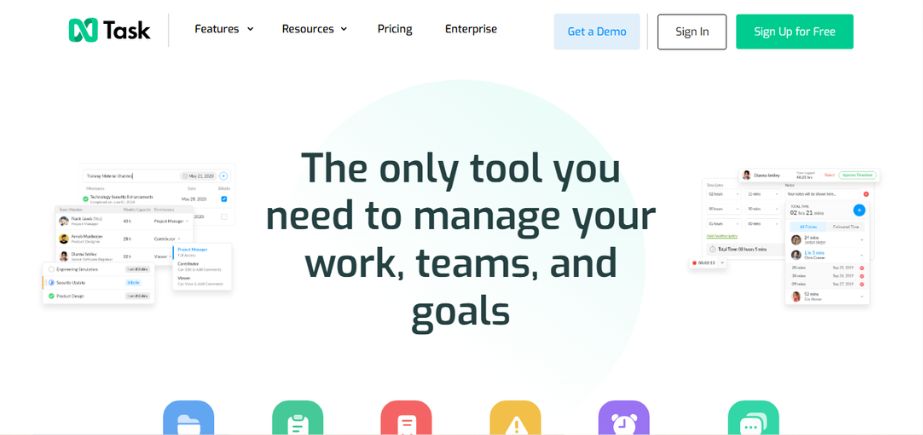
nTask is a project management software integrated with features designed for Agile teams, including task boards, Gantt charts, timesheets, and meeting management. It supports Scrum flows through backlog prioritization, sprints, and team collaboration features. With robust reporting capabilities and risk-tracking functionality, nTask is best suited for both technical and non-technical teams looking for a lightweight but scale-up Agile solution that is also affordable for small businesses.
Key Features:
- Task and milestone management
- Sprint planning and backlog management
- Time and risk tracking
- Gantt charts and Kanban boards
Pros:
- Affordable with comprehensive feature set
- Great UI for team collaboration
Cons:
- Scrum features not as deep as competitors
- Limited reporting for large projects
Pricing:
Free for basic use; paid plans start at $3/user/month
Who Should Use It?
Small teams and startups looking for affordable all-in-one task and Agile management.
14. VivifyScrum
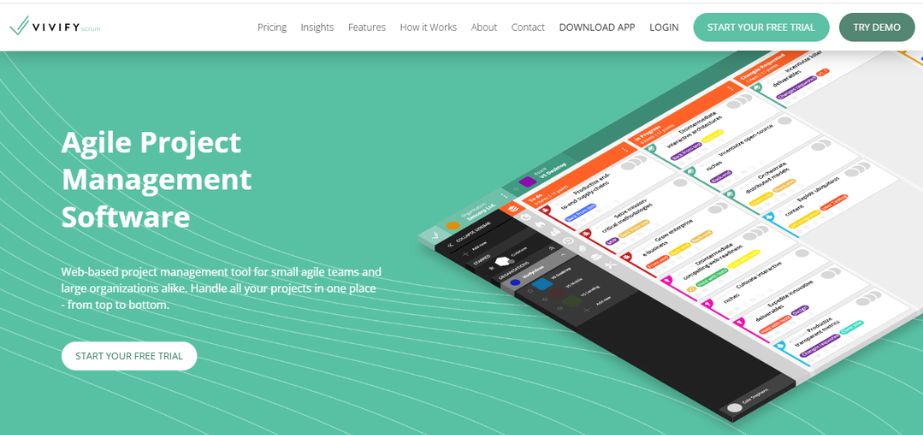
VivifyScrum is a one-stop Agile tool that can support Scrum, Kanban, and hybrid processes. It has sprint planning, backlog management, time tracking, invoicing, and team collaboration in a single dashboard. With client management capabilities built-in, it is ideal for Agile agencies or individual freelancers looking to handle multiple clients and projects. VivifyScrum is lightweight and cloud-based and comes in handy for teams of any size.
Key Features:
- Scrum and Kanban boards
- Time tracking and invoicing
- Burndown charts and team management
- GitHub and GitLab integration
Pros:
- Affordable and full-featured
- Supports freelancers and small teams with built-in invoicing
Cons:
- UI can feel dated
- Mobile experience is limited
Pricing:
Starts at $10/month for up to 10 users
Who Should Use It?
Freelancers, consultants, and small Agile teams needing task tracking plus billing and time tools.
15. Yodiz
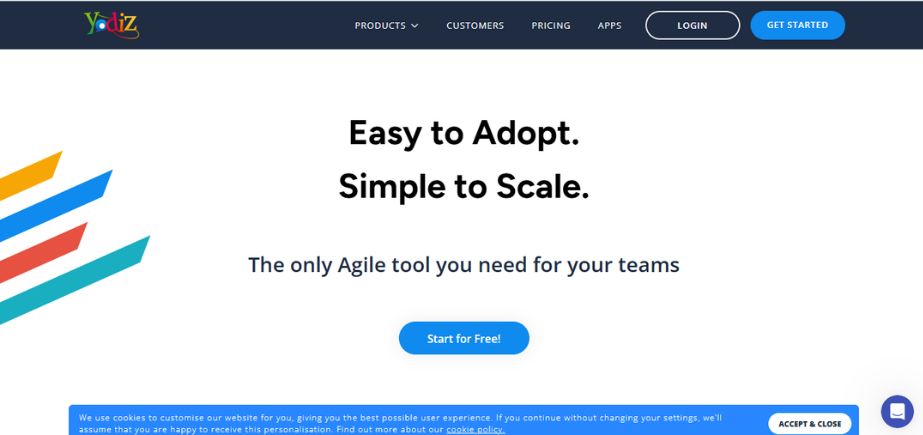
Yodiz is a feature-packed Agile tool for Scrum, Kanban, and issue tracking. It provides rich features like epic and user story management, sprint planning, release tracking, and burndown charts. Yodiz also has a good bug tracker and real-time analytics, which makes it ideal for software development teams. With competitive pricing and a good focus on productivity, it’s an excellent choice for growing Agile teams.
Key Features:
- Scrum and Kanban boards
- Epic and release management
- Time tracking and burndown charts
- Integrations with GitHub, Bitbucket, Slack
Pros:
- Great feature-to-price ratio
- Suitable for both product and project management
Cons:
- Interface can feel cluttered
- Occasional performance issues with large projects
Pricing:
Free for up to 3 users; paid plans start at $3/user/month
Who Should Use It?
Startups and growing teams that need a budget-friendly Scrum and issue-tracking tool.
16. MeisterTask
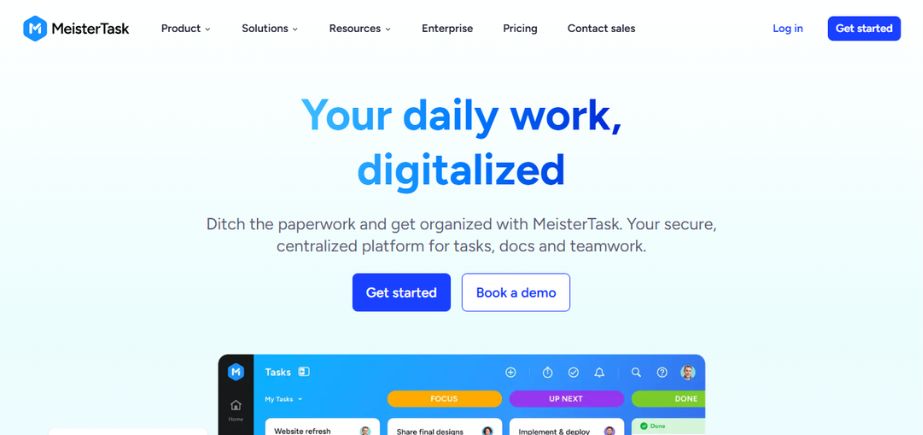
MeisterTask is a clean, visual task management application that accommodates Agile processes such as Scrum and Kanban. Although it lacks conventional Scrum-specific features such as sprint velocity measurement and burndown charts, it shines in task structure, collaboration, and automation. It’s perfect for marketing teams, startups, and marketers who need an uncluttered tool with easy drag-and-drop boards and seamless integration with tools such as MindMeister and Slack.
Key Features:
- Customizable Kanban-style boards
- Timeline and project planning
- Built-in time tracking
- Integration with MindMeister, Slack, and GitHub
Pros:
- Clean, intuitive UI with great UX
- Easy integration with visual planning via MindMeister
Cons:
- Lacks advanced Scrum-specific features
- Reporting capabilities are limited
Pricing:
Free plan available; paid plans start at $7/user/month
Who Should Use It?
Design teams, startups, and creative agencies looking for lightweight task management with visual planning.
17. Axosoft
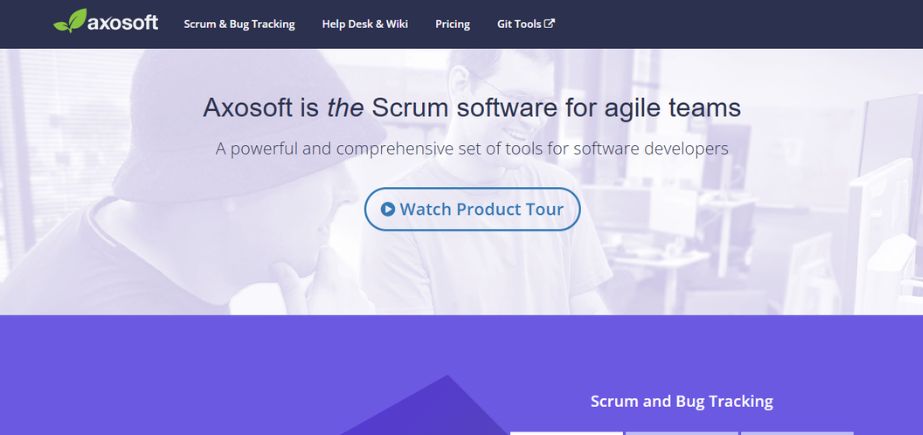
Axosoft is a Scrum-harmonized project management software designed specifically for software development teams. It offers sprint planning, release management, velocity charts, and a rather innovative “Daily Scrum” dashboard. Burndown charts, issue tracking, and integration with GitHub make it a great choice for dev teams requiring a useful Scrum platform. Axosoft features customer portals and bug tracking and is appropriate for Agile teams that have to work on client feedback and QA procedures.
Key Features:
- Backlog and sprint planning
- Bug tracking and issue management
- Burndown charts and velocity reports
- Release management and Scrum dashboards
Pros:
- Dev-focused with deep Scrum support
- Advanced tracking and analytics
Cons:
- Interface feels a bit outdated
- Learning curve for non-tech teams
Pricing:
Starts at $105/month for 5 users
Who Should Use It?
Software development teams looking for in-depth Scrum implementation and tracking tools.
18. Kanbanize (Now, Businessmap)
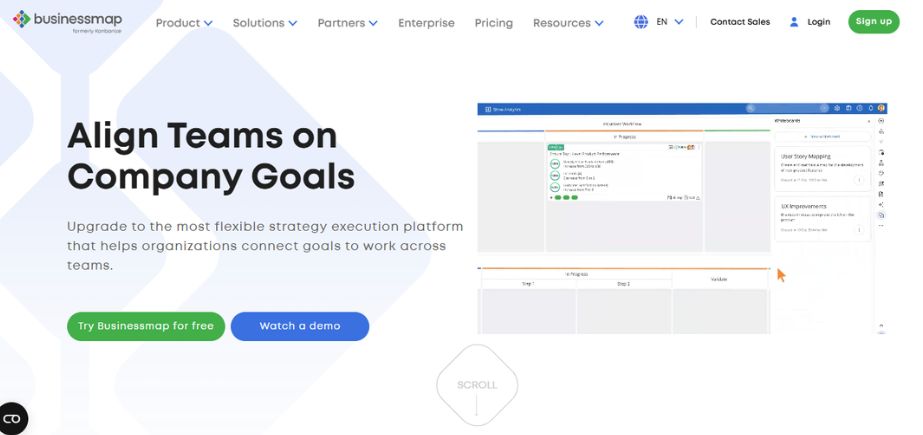
Kanbanize is a strong Agile project management tool that combines Scrum and Kanban features. It offers visual workflow management, WIP limits, automation rules, planning views by timeline, and real-time analytics. It’s ideal for mid-to-large teams that want to scale Agile practice without sacrificing lean efficiency. It’s an excellent choice for those who enjoyed the flexibility of Agilefant but desired more sophisticated visualization and automation.
Key Features:
- Customizable Kanban Boards
- Advanced Analytics and Reporting
- Seamlessly connect with tools such as Trello, GitHub, and Google Drive
- Automate repetitive tasks
Pros:
- User-Friendly Interface
- Suitable for teams of various sizes
Cons:
- Limited Resource Management Features
- Dependency on Third-Party Integrations
Pricing:
Free, $149/15 users
Who Should Use It?
Kanbanize is ideal for organizations across various industries including IT, engineering, and manufacturing that seek to implement Agile methodologies and improve workflow visualization.
19. IceScrum
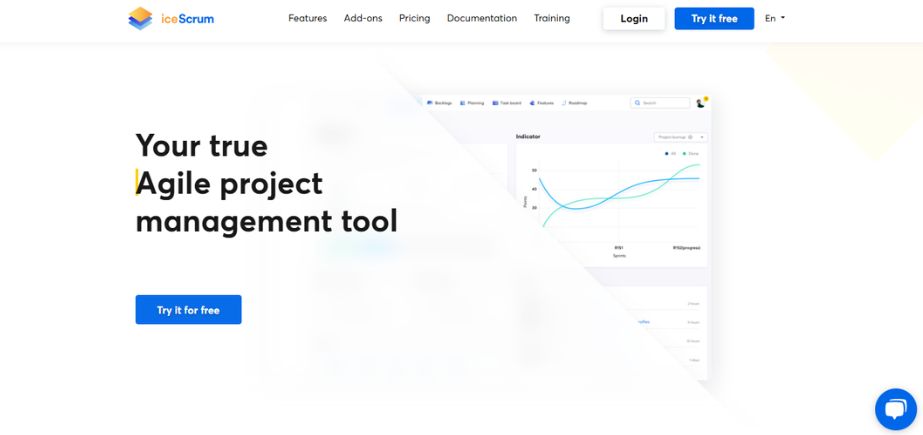
IceScrum is an open-source Scrum and Agile project management tool that facilitates end-to-end Agile workflows, that’s, vision and backlogs through releases and sprints. It has features such as user roles, team planning, dashboards, and customizable boards. IceScrum is very customizable and one of the best scrum tools for development teams that require flexibility as well as robust Agile features. It’s especially attractive for technical teams or organizations looking for more control over hosting and customizing.
Key Features:
- Sprint and release planning
- Visual boards and timelines
- Role-based collaboration
- Open-source and hosted options
Pros:
- Open-source version available
- Good for hybrid Agile approaches
Cons:
- Can be difficult to set up
- UI not very modern
Pricing:
Free open-source version; hosted plans start at €8.90/team/month
Who Should Use It?
Teams looking for open-source Scrum solutions or organizations with in-house hosting capabilities.
Comparison Between the Best Scrum Tools
The following table gives the details of the key features, starting price, use cases and websites of the best scrum tools:
| Tool Name | Key Features | Pricing (Starting) | Use Cases | Website |
| Jira | Scrum boards, backlog grooming, burndown charts, workflows | $7.53/user/month | Software development, Agile teams | https://www.atlassian.com/software/jira |
| Trello | Kanban boards, checklists, power-ups (integrations), automation | Free, $5+/user/month | Simple Scrum boards, small teams, personal task tracking | https://trello.com |
| Asana | Timeline, task dependencies, automation, reporting | Free, $10.99+/month | Marketing teams, project managers, Agile task planning | https://asana.com |
| Monday.com | Visual boards, time tracking, automation, integrations | $9/user/month | Cross-functional teams, product roadmapping | https://monday.com |
| ClickUp | Docs, goals, Gantt charts, dashboards, Scrum board | Free, $7/user/month(Annual pack) | All-in-one work management for any team size | https://clickup.com |
| Zoho Sprints | Scrum boards, backlog management, timesheets, epics | ₹70/user/month | Agile product development, remote teams | https://zoho.com/sprints |
| Wrike | Gantt charts, custom workflows, reports, time tracking | Free, $10/month | Enterprise project tracking, marketing, PMOs | https://wrike.com |
| Targetprocess | Portfolio management, roadmaps, customizable workflows | Custom pricing | Scaled Agile frameworks (SAFe), large organizations | https://targetprocess.com |
| VersionOne | Roadmapping, sprint planning, reporting, backlog prioritization | Custom pricing | Enterprise Agile planning | https://www.version1.com/ |
| Rally Software | Capacity planning, Kanban/Scrum, release tracking, dashboards | Custom pricing | Software teams, enterprise Agile at scale | https://broadcom.com/products/software/enterprise-software/agile-development/rally-software |
| Scrumwise | Sprint planning, backlog management, burndown charts | $7.50/user/month (yearly plan) | Agile software teams, startups | https://scrumwise.com |
| Taiga | Scrum/Kanban boards, backlog, wiki, issue tracking | Free, $70/month | Developers, open-source projects, startups | https://taiga.io |
| Pivotal Tracker | Stories, velocity tracking, integrations, project analytics | Free, custom pricing | Dev teams, startup product planning | https://pivotaltracker.com |
| VivifyScrum | Agile boards, invoicing, time tracking, CRM | $10/team/month | Freelancers, small Agile teams | https://vivifyscrum.com |
| Yodiz | Release planning, epic/story management, analytics | $3/user/month | End-to-end Agile lifecycle, SMBs | https://yodiz.com |
| MeisterTask | Kanban boards, timelines, integrations, checklists | Free, $7/month | Creative teams, task planning, freelancers | https://meistertask.com |
| Axosoft | Scrum planning board, backlog, velocity chart, release planner | $105/5 users/month | Agile software dev teams | https://axosoft.com |
| Kanbanize | Themes, backlog, sprints, time tracking | Free, $149/15 users | Software dev, R&D teams | https://businessmap.io/ |
| IceScrum | User stories, tasks, features, Scrum artifacts, integrations | Free, €8.90/team/month | Educational, startups, R&D | https://www.icescrum.com/ |
| nTask | Gantt charts, timesheets, risk management, meeting tools | Free, $3+/month | PMs, Agile teams, freelancers | https://ntaskmanager.com |
Conclusion
Choosing the best Scrum tool can make a huge difference in team collaboration, sprint planning, and project delivery. For enterprise-level features, Jira is an excellent choice, but Trello and Asana are ideal for teams seeking simplicity and visual task management. ClickUp and Monday.com offer excellent customization and all-in-one workspace capabilities.
Startups and small teams may find tools like Scrumwise or Taiga to be appropriate because of ease of use and affordability. If your focus is development workflows, then both Pivotal Tracker and Targetprocess are excellent options. What works best ultimately is up to your team size, workflow complexity, and integration needs. Experiment with some of them with your team before committing to ensure compatibility with your Agile practices and project goals.
FAQs
1. What should be the most important features of the best Scrum tool?
the best scrum tool seek sprint planning, backlog, user story tracking, real-time collaboration, reporting, and integration with other tools like GitHub, Slack, or Jira.
2. What is the best Scrum tool for small teams or startups?
Scrum tools such as Trello, Taiga, and Scrumwise are also best suited for small teams because they are simple, inexpensive, and have an easy-to-use interface.
3. Do Scrum tools support integration with other software?
The majority of the best Scrum tools do support integration with other popular platforms such as Slack, GitHub, Jira, Zoom, and Google Workspace, to name a few, for streamlined workflow and communication.
4. Are there free Scrum tools?
Yes, there are some free Scrum tool like Trello, ClickUp (small plan), and Taiga, all have free plans with their core features, which are ideal for solo use or small teams.
5. What Scrum tool should I use for my team?
Look at how big your company is, your budget, how much functionality you need (e.g., reporting, automation, integration), and how simple it is. All have free trials, so it is worth trying a couple out before committing.
